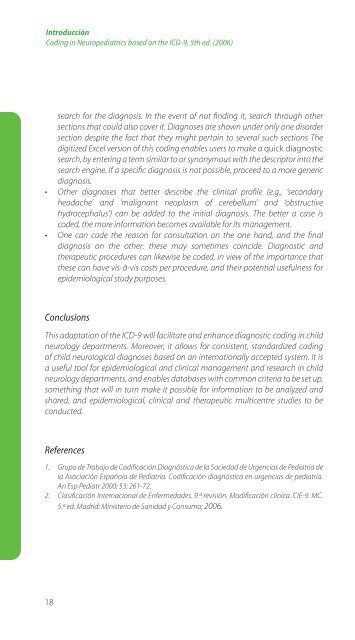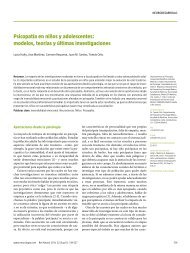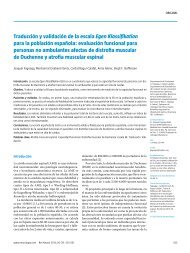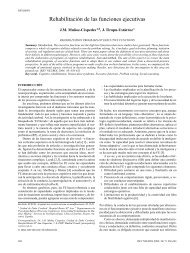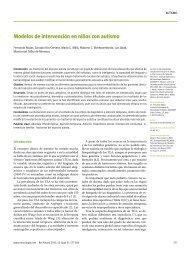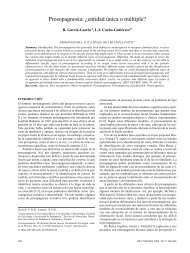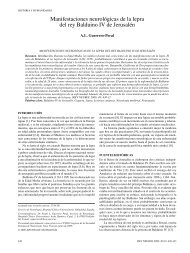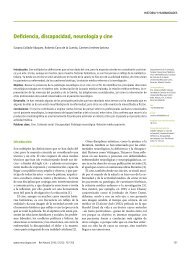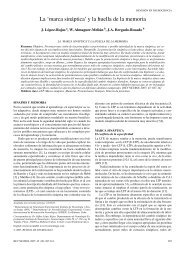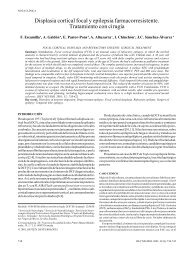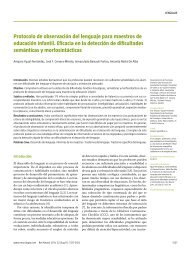Codificación en Neurología Pediátrica (CIE-9) - Revista de Neurología
Codificación en Neurología Pediátrica (CIE-9) - Revista de Neurología
Codificación en Neurología Pediátrica (CIE-9) - Revista de Neurología
You also want an ePaper? Increase the reach of your titles
YUMPU automatically turns print PDFs into web optimized ePapers that Google loves.
Introducción<br />
Coding in Neuropediatrics based on the ICD-9, 5th ed. (2006)<br />
search for the diagnosis. In the ev<strong>en</strong>t of not finding it, search through other<br />
sections that could also cover it. Diagnoses are shown un<strong>de</strong>r only one disor<strong>de</strong>r<br />
section <strong>de</strong>spite the fact that they might pertain to several such sections The<br />
digitized Excel version of this coding <strong>en</strong>ables users to make a quick diagnostic<br />
search, by <strong>en</strong>tering a term similar to or synonymous with the <strong>de</strong>scriptor into the<br />
search <strong>en</strong>gine. If a specific diagnosis is not possible, proceed to a more g<strong>en</strong>eric<br />
diagnosis.<br />
• Other diagnoses that better <strong>de</strong>scribe the clinical profile (e.g., ‘secondary<br />
headache’ and ‘malignant neoplasm of cerebellum’ and ‘obstructive<br />
hydrocephalus’) can be ad<strong>de</strong>d to the initial diagnosis. The better a case is<br />
co<strong>de</strong>d, the more information becomes available for its managem<strong>en</strong>t.<br />
• One can co<strong>de</strong> the reason for consultation on the one hand, and the final<br />
diagnosis on the other: these may sometimes coinci<strong>de</strong>. Diagnostic and<br />
therapeutic procedures can likewise be co<strong>de</strong>d, in view of the importance that<br />
these can have vis-à-vis costs per procedure, and their pot<strong>en</strong>tial usefulness for<br />
epi<strong>de</strong>miological study purposes.<br />
Conclusions<br />
This adaptation of the ICD-9 will facilitate and <strong>en</strong>hance diagnostic coding in child<br />
neurology <strong>de</strong>partm<strong>en</strong>ts. Moreover, it allows for consist<strong>en</strong>t, standardized coding<br />
of child neurological diagnoses based on an internationally accepted system. It is<br />
a useful tool for epi<strong>de</strong>miological and clinical managem<strong>en</strong>t and research in child<br />
neurology <strong>de</strong>partm<strong>en</strong>ts, and <strong>en</strong>ables databases with common criteria to be set up,<br />
something that will in turn make it possible for information to be analyzed and<br />
shared, and epi<strong>de</strong>miological, clinical and therapeutic multic<strong>en</strong>tre studies to be<br />
conducted.<br />
Refer<strong>en</strong>ces<br />
1. Grupo <strong>de</strong> Trabajo <strong>de</strong> <strong>Codificación</strong> Diagnóstica <strong>de</strong> la Sociedad <strong>de</strong> Urg<strong>en</strong>cias <strong>de</strong> Pediatría <strong>de</strong><br />
la Asociación Española <strong>de</strong> Pediatría. <strong>Codificación</strong> diagnóstica <strong>en</strong> urg<strong>en</strong>cias <strong>de</strong> pediatría.<br />
An Esp Pediatr 2000; 53: 261-72.<br />
2. Clasificación Internacional <strong>de</strong> Enfermeda<strong>de</strong>s. 9.ª revisión. Modificación clínica. <strong>CIE</strong>-9. MC.<br />
5.ª ed. Madrid: Ministerio <strong>de</strong> Sanidad y Consumo; 2006.<br />
18


